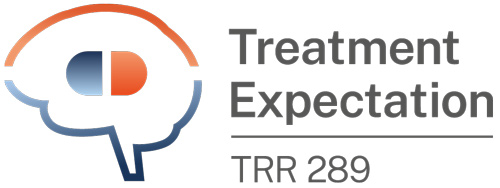Patterns of activity can be seen in certain parts of the brain when participants are told they will feel pain. © SFB Treatment Expectation
Patterns of activity can be seen in certain parts of the brain when participants are told they will feel pain. © SFB Treatment Expectation
How we create our own expectations – and the role that attention plays in this
When a person is feeling pain, this can be detected using imaging techniques like functional magnetic resonance imaging (fMRI) in the form of patterns of neuronal activation. And that’s not all: Even the mere expectation of pain leads to similar patterns. This enables researchers to observe, without external intervention into the brain, how study participants’ expectations of pain and of pain treatment change due to various different factors.
Side effects can even be useful
In the first funding period of Project A02, we showed that in certain cases, mild side effects can have a positive influence on people’s treatment expectations and can therefore reduce their perception of pain. This is even the case if the side effects themselves are unpleasant, as long as they are associated with the impact of the treatment. The findings so far also show that a feeling of agency can have positive effects: For instance, if people are able to initiate a pain relief treatment themselves, it works better than if the treatment is initiated by someone else.
How does self-efficacy influence our expectations?
In the second funding period, we’re now looking in greater detail at the influence of self-efficacy on expectations and pain. In particular, we’re focusing on the observation that a sense of agency not only strengthens the influence of our expectations but even directly changes them. Does this happen because our ability to take action brings about a shift in our attention? And how does this influence our perception of pain? In the coming years, we will search for answers to these questions, which are hugely important for everyday clinical practice.
To this aim, Project A02 will use fMRI measurements as well as behavioural observations of our study participants, and we will also use skin conductance measures (electrodermal activity, abbreviated to EDA). These different data will be entered into computational models in order to obtain a deeper understanding of how treatment expectations develop and how they change when our expectations are fulfilled.
Geuter S, Boll S, Eippert F, Büchel C (2017) Functional dissociation of stimulus intensity encoding and predictive coding of pain in the insula. eLife 6. PubMed
Horing B, Sprenger C, Büchel C (2019) The parietal operculum preferentially encodes heat pain and not salience. PLOS Biology 17:e3000205. PubMed
Wimmer EG, Büchel C (2019) Learning of distant state predictions by the orbitofrontal cortex in humans. Nature Communications 10:2554. PubMed
In close cooperation with these projects
How expectations influence stomach ache – and how the experience of pain changes treatment expectations
Prof. Dr. Sigrid Elsenbruch
PD Dr. Julian Kleine-Borgmann
How do expectations control our emotions - and what does attention have to do with it?
Prof. Dr. Stefanie Brassen
What role does the cerebellum play in placebo and nocebo effects?
Prof. Dr. Dagmar Timmann
Warmth, competence and more: What practitioners can achieve through communication
Prof. Dr. Helen Blank
Prof. Dr. Katja Wiech
Project Lead

Prof. Dr. Christian Büchel
Neuroscientist
Team
Dr. Lieven Schenk
Postdoc, Psychologist, Neuroscientist
Zoe Hilker
PhD student, Psychologist, Neuroscientist
Jonathan Jeßberger
Medical student


